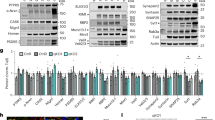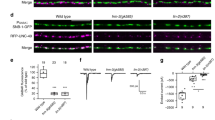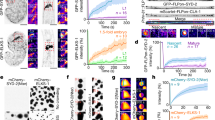Abstract
At synaptic junctions, specialized subcellular structures occur in both pre- and postsynaptic cells. Most presynaptic termini contain electron-dense membrane structures1, often referred to as active zones, which function in vesicle docking and release2. The components of those active zones and how they are formed are largely unknown. We report here that a mutation in the Caenorhabditis elegans syd-2 (for synapse-defective) gene causes a diffused localization of several presynaptic proteins and of a synaptic-vesicle membrane associated green fluorescent protein (GFP) marker3,4. Ultrastructural analysis revealed that the active zones of syd-2 mutants were significantly lengthened, whereas the total number of vesicles per synapse and the number of vesicles at the prominent active zones were comparable to those in wild-type animals. Synaptic transmission is partially impaired in syd-2 mutants. syd-2 encodes a member of the liprin (for LAR-interacting protein) family of proteins which interact with LAR-type (for leukocyte common antigen related) receptor proteins with tyrosine phosphatase activity (RPTPs)5,6. SYD-2 protein is localized at presynaptic termini independently of the presence of vesicles, and functions cell autonomously. We propose that SYD-2 regulates the differentiation of presynaptic termini in particular the formation of the active zone, by acting as an intracellular anchor for RPTP signalling at synaptic junctions.
This is a preview of subscription content, access via your institution
Access options
Subscribe to this journal
Receive 51 print issues and online access
$199.00 per year
only $3.90 per issue
Buy this article
- Purchase on Springer Link
- Instant access to full article PDF
Prices may be subject to local taxes which are calculated during checkout





Similar content being viewed by others
References
Landis,D. M. D., Hall,A. K., Weinstein,L. A. & Reese,T. S. The organization of cytoplasm at the presynaptic active zone of a central nervous system synapse. Neuron 1, 201–209 (1988).
Südhof,T. C. The synaptic vesicle cycle: a cascade of protein–protein interactions. Nature 375, 645–653 (1995).
Nonet,M. L. Visualization of synaptic specializations in live C. elegans with synaptic vesicle protein-GFP fusions. J. Neurosci. Methods 89, 33–40 (1999).
Hallam,S. & Jin,Y. lin-14 regulates the timing of synaptic remodeling in Caenorhabditis elegans. Nature 395, 78–80 (1998).
Serra-Pagès,C. et al. The LAR transmembrane protein tyrosine phosphatase and a coiled-coil LAR-interacting protein co-localize at focal adhesions. EMBO J. 14, 2827–2838 (1995).
Serra-Pagès,C., Medley,Q. G., Tang,M., Hart,A. & Streuli,M. Liprins, a family of LAR transmembrane protein-tyrosine phosphatase-interacting proteins. J. Biol. Chem. 273, 15611–156201 (1998).
Rand,J. B. & Nonet,M. Synaptic transmission. In C. elegans II (eds Riddle, D., Blumenthal, T., Meyer, B. & Priess, J. R.) 611–643 (Cold Spring Harbor Laboratory Press, New York, 1997).
Jin,Y., Jorgensen,E., Hartwieg,E. & Horvitz,H. R. The Caenorhabditis elegans gene unc-25 encodes gutamic acid decarboxylase and is required for synaptic transmission but not synaptic development. J. Neurosci. 19, 539–548 (1999).
White,J. G., Southgate,E., Thomson,J. N. & Brenner,S. The structure of the nervous system of the nematode Caenorhabditis elegans. Phil. Trans. R. Soc. Lond. B 314, 1–340 (1986).
Stapleton,D., Balan,I., Pawson,T. & Sicheri,F. The crystal structure of an Eph receptor SAM domain reveals a mechanism for modular dimerization. Nature Struct. Biol. 6, 44–49 (1999).
Yochem,J., Gu,T. & Han,M. A new marker for mosaic analysis in Caenorhabditis elegans indicates a fusion between hyp6 and hyp7, two major components of hypodermis. Genetics 149, 1323–1334 (1998).
Hall,H. & Hedgecock,M. Kinesin-related gene unc-104 is required for axonal transport of synaptic vesicles in C. elegans. Cell 65, 837–847 (1991).
Trent,C., Tsung,N. & Horvitz,H. R. Egg-laying defective mutants of the nematode C. elegans. Genetics 104, 619–647 (1983).
Burns,M. E. & Augustine,G. J. Synaptic structure and function: dynamic organization yields architectural precision. Cell 83, 187–194 (1995).
Thomas,U. et al. Synaptic clustering of the cell adhesion molecule Fasciclin II by Discs-Large and its role in the regulation of presynaptic structure. Neuron 19, 787–799 (1997).
Sone,M. et al. Still life, a protein in synaptic terminals of Drosophila homologous to GDP-GTP exchangers. Science 275, 543–547 (1998).
Rosahl,T. W. et al. Essential functions of synapsins I and II in synaptic vesicle regulation. Nature 375, 488–493 (1995).
Wang,Y., Okamoto,M., Schmitz,F., Hofmann,K. & Südhof,T. C. Rim is a putative RAB3 effector in regulating synaptic-vesicle fusion. Nature 388, 593–598 (1997).
tom Dieck,S. et al. Bassoon, a novel zinc-finger CAG/Glutamine-repeat protein selectively localized at the active zone of presynaptic nerve termini. J. Cell Biol. 142, 499–509 (1998).
Jorgensen,E. et al. Defective recycling of synaptic vesicles in synaptotagmin mutant of Caenorhabditis elegans. Nature 378, 196–199 (1995).
Nonet,M. et al. Caenorhabditis elegans rab-3 mutant synapses exhibit impaired function and are partially depleted of vesicles. J. Neurosci. 17, 8061–8073 (1997).
Betz,W. J. & Henkel,A. W. Okadaic acid disrupts clusters of synaptic vesicles in frog motor nerve terminals. J. Cell Biol. 124, 843–854 (1994).
Kraszewski,K. et al. Synaptic vesicle dynamics in living cultured hippocampal neurons visualized with CY3-conjugated antibodies directed against the lumenal domain of synaptotagmin. J. Neurosci. 15, 4328–4342 (1995).
Desai,C. J., Gindhart, J. G. Jr, Goldstein,L. S. & Zinn,K. Receptor tyrosine phosphatases are required for motor axon guidance in the Drosophila embryo. Cell 84, 599–609 (1996).
Brenner,S. The genetics of Caenorhabditis elegans. Genetics 77, 71–94 (1974).
Mello,C. C., Kramer,J. M., Stinchcomb,D. & Ambros,V. Efficient gene transfer in C. elegans: extrachromosomal maintenance and integration of transforming sequence. EMBO, J. 10, 3959–3970 (1991).
Finney,M. & Ruvkun,G. B. The unc-86 gene product couples cell lineage and cell identity in C. elegans. Cell 63, 895–905 (1990).
Hedgecock,E. M., Culotti,J. G. & Hall,D. H. The unc-5, unc-6, unc-40 genes guide circumferential migrations of pioneer axons and mesodermal cells on the epidermis in C. elegans. Neuron 2, 61–85 (1990).
Acknowledgements
We thank M. Nonet for SNB-1::GFP DNA and antibodies for SNT-1, SNB-1, syntaxin and RAB-3; Y. Kohara for the yk100c11 clone; A. Fire for the GFP vectors; M. Han for the pTG96 plasmid; C. elegans genome consortium for the sequence and clone of cosmid F59F5; A. Chisholm, E. Jorgensen and M. Nonet for helpful discussion throughout this work; E. Hartwieg for teaching us electron micrograph analysis; and R. Horvitz for his generosity. A. Chisholm, J. Kaplan, G. Garriga, L. Hinck, A. Zahler, R. Baran, Y. Ho and members of the Chisholm and Jin laboratories made comments on this paper. Some strains used in this work were obtained from the Caenorhabditis elegans Genetics Center, which is funded by NIH Center for research resources. M.Z. is supported by a Human Frontier Science Program Long Term Postdoctoral Fellowship. Y.J. is a Alfred P. Sloan research fellow. This work was supported by US PHS research grant NS35546 to Y.J. The GenBank accession numbers for syd-2 genomic DNA and cDNA are Z50794 and AF170122, respectively.
Author information
Authors and Affiliations
Corresponding author
Rights and permissions
About this article
Cite this article
Zhen, M., Jin, Y. The liprin protein SYD-2 regulates the differentiation of presynaptic termini in C. elegans. Nature 401, 371–375 (1999). https://doi.org/10.1038/43886
Received:
Accepted:
Issue Date:
DOI: https://doi.org/10.1038/43886
This article is cited by
-
Bright lights, big synapses: fluorescent proteins let neurons shine
BMC Biology (2024)
-
Liprin-α proteins are master regulators of human presynapse assembly
Nature Neuroscience (2024)
-
Liprins in oncogenic signaling and cancer cell adhesion
Oncogene (2021)
-
Vertebrate Presynaptic Active Zone Assembly: a Role Accomplished by Diverse Molecular and Cellular Mechanisms
Molecular Neurobiology (2018)
-
Liprin-α-1 is a novel component of the murine neuromuscular junction and is involved in the organization of the postsynaptic machinery
Scientific Reports (2017)
Comments
By submitting a comment you agree to abide by our Terms and Community Guidelines. If you find something abusive or that does not comply with our terms or guidelines please flag it as inappropriate.



